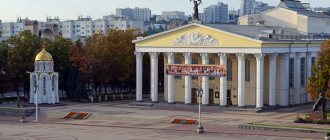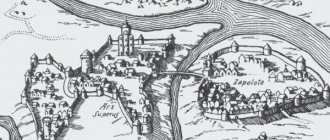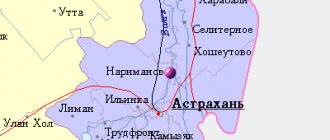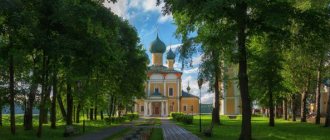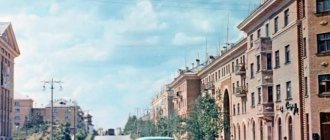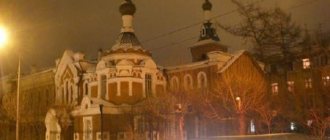↑ Sobinka city history
In ancient times, the place where the city of Sobinka is located was called a wasteland. Because there were swamps and impenetrable forests around. With the development of the Moscow - Nizhny Novgorod railway, the town has development prospects.
In the mid-19th century, in 1856, the Losev brothers Matvey and Luka acquired a plot of Sobinskaya wasteland. The brothers organized a textile factory on the purchased land. It is noteworthy that the equipment for the factory was ordered from England, so the production was innovative and modern for its time.
Production developed, and so did the city. New houses, a church, a school, a hospital. In the 60s of the 19th century, a bridge was built across the Klyazma. Transport accessibility of Sobinka has become significantly better and has given a new impetus to development.
After the 1917 revolution, life changed. The factory received a new domestic equipment name - “Communist Avant-Garde”. And in 1939, the working settlement of Sobinka received the status of the year. The years of the Great Patriotic War struck with thunder. About three thousand soldiers went to the front to defend the Fatherland. Half of them did not return home.
In the post-war years, a new weaving factory appeared in the city, which became a catalyst for the expansion of the city, the reason for the emergence of a new microdistrict. Over the past decades, the city has been actively being cleaned up. Dilapidated housing and wooden barracks are being demolished. In their place there appears housing that corresponds to the spirit of the times.
Sobinka is a city in the Vladimir region, the administrative center of the Sobinsky district. The municipality of the same name forms the city of Sobinka with the status of an urban settlement as the only settlement in its composition. Attempts to explain the toponym (geographical name) Sobinka have been made repeatedly. According to the assumption of the author of the “Toponymic Dictionary of Central Russia” G.P. Smolitskaya, the name of the city is derived from the Old Russian personal name (nickname) Sobin, which is based on the word “sobin”, known in the dialects of Central Russia in different meanings: “a person with some kind of individual, own peculiarity” or “own belongings, property”. The famous dictionary of V.I. Dalia contains many words of this root: sob, sobina, sobinnik, sobinka and others. Perhaps the original name of the wasteland does not come from the name or nickname “sobin” and not from the words “sob”, “own”, but from the words “special”, “special” (meaning “separate”). In colloquial pronunciation, the word “special” is very close to “sobenny”, “sobinny”, “sobinsky”. Among the many options for naming the wasteland, such options were also encountered at different times. Already in 1675, the hayfields added to the Kononova wasteland were called “special.” In a document of 1761, it is found “in the wastelands of Kononov, Korobeyka, in Luka Osobennoy Lopata also, in the Cow Swamp and in Bor...”. On October 30, 1780, at the Patrimonial Collegium, they heard a certificate “for the Volodymersky district about the wastelands of Lopata Osobinaya Luka, the possession of the maidens countesses Natalya and Katerina Alexandrov, daughters of the Golovins, with other owners...” The city is located in an area that by its nature was known as Sobennaya (Sobina) wasteland , from the word “special” meaning “isolated”, “remote”, “separate”. The name of the wasteland itself in documents of the 17th - 19th centuries. found in dozens of variants. Most often, the wasteland was called Sobina Luka spade, also, especially in strict boundary documents (luka - floodplain meadow, grassy hollow; bend of the river). Often there are the Sobinnaya Lopata wasteland, the Sobenennaya Luka wasteland, the Sobinskaya Luka shovel wasteland, the Sobinskaya wasteland, the Sobin Luka wasteland, the Sobinnaya Luka Lopata wasteland, too, the Sobinskaya Luka Lopata wasteland, too, and other options. The State Archives of the Vladimir Region contains a file about the lawsuit between the collegiate assessor Vasily Fedorovich Alyabyev and the chamberlain Count Alexander Nikolaevich Zubov about the wasteland of Sobina Luka Lopata also. It lasted from 1836 to 1846. The case allows us to more fully judge the place where the city of Sobinka is now located. In the disputed wasteland there were then 1385 dessiatines 355 fathoms of timber and firewood, 55 dessiatines 2000 fathoms of hay cutting, 60 dessiatines 260 fathoms under the river and lakes, that is, more than 1500 dessiatines. On the Mende Map of 1850, only two tiny farms on the banks of the Klyazma are noted in these places. K ser. In the 19th century, part of the wasteland of Sobina Luka and Lopata was owned by the Vladimir 1st guild merchant son and honorary citizen of the mountains. Vladimir Alexander Andreevich Nikitin (1823-1867). On April 30, 1859, the factory of the Sobinskaya Manufactory of Paper Products was opened. In January 1922, the Vladimir Cotton and Paper Trust was formed. On July 1, 1923, the Alexander Trust merged into the Vladimir Trust. “Communist Avant-Garde”
for the active participation of the Sobinsky proletariat in the socialist October Revolution and the Civil War, as well as for the establishment of Soviet power on the site . See "Communist Vanguard" factory. At the beginning of December 1922, a proletarian club was organized at the factory. On November 7, 1923, on the day of celebration of the 6th anniversary of the October Revolution, a monument to Karl Marx was unveiled. “In the workers’ settlement newly built at the Communist Avangard factory, the cowsheds burned down in 1923. Again they were not built and now the workers have to walk a quarter of a mile to their cows. You need to get up at 3 o'clock in order to have time to clean and feed the cattle, and then go to work on the morning shift. The administration should take care of building cowsheds closer to the workers’ homes” (“Call,” November 5, 1924).
On April 5, 1925, Gubernia Transport organized a trial run of the Vladimir-Sobinka bus and back.
In the 1920s, a drainage collector was laid along the future Lenin Street, where two-story wooden houses for workers were soon built.
There were practically no street names in those years; instead of them there were villages. In this part of the city there were the village of Serp and Molot, the Rabochy settlement and the village of Pervomaisky. Across the river was the old part of the settlement, it was called Bolshiye and Malyye Sokolniki. Next to the narrow-gauge railway stood the houses of the village of Sobinets. "The life of workers. The Communist Vanguard factory employs 7,000 workers, most of whom receive 35 rubles. per month. Housing conditions are still poor. At a distance of half a mile there are 8 dormitory buildings crowded together. The buildings are three-story with a common kitchen. Each building has a children's or kindergarten serving an average of 60 people. children. Those who do not attend are approximately 4 percent. Kindergartens are not completely filled, since parents pay little attention to their children. Each dormitory building, which looks decent, houses 250 families. The crowding and cramped conditions are enormous. Inside the buildings are divided into closets, ranging in size from 4 to 6 cubic meters. The closets are filled with about 8 people, the workers are housed in them like chickens on a roost, since each closet has bunks. Some of the workers live in houses in a village located on the edge of a pine forest. The houses are two-story, with four apartments, a porch, a convenient cellar and a cowshed. It's nice and nice to look at this beautiful street. It is not life, but paradise, but this paradise is not yet for everyone. Recently there was a meeting of the plenum of the factory committee, at which it was decided to consolidate the employees living in two-story houses. They decided to make a decision, but it is not put into practice. The construction of a commune house among the “Comavant Guards” is overdue. The workers are looking forward to this building. Only then will the workers breathe freely when they leave their chicken coops. Then they will have more strength and health for the overall work of increasing labor productivity. Mutual aid fund. The mutual aid fund has become sufficiently strong, its financial condition has improved, so that it has already been able to take more than 30 shares from the housing construction cooperative, thus providing assistance to housing construction. In order to strengthen its funds, the cash desk is developing trade in the buffet. Loans and benefits are issued to workers on a weekly basis, and irrevocably to those most in need. Among the workers. At Sobinka, the worker takes too little part in social work, since production operates on 2 shifts, and all public work begins at 9 pm. Despite all her desires, the worker is unable to go to the club because the nursery is open until 9 pm and from that time on she must, after coming home from work, babysit the children. With the proposed expansion of the nurseries and the extension of their opening hours to 12 or 1 o'clock in the morning, the female worker will be freed up and will take part in all the work on an equal basis with the man. The lack of a public canteen and laundry is a great grief for a worker. Having worked her eight hours, the worker still has to prepare food, serve it, wash dishes, wash clothes, etc. All this requires a lot of time and effort. The factory committee needs to seriously think about this issue, come to an agreement with the people and move things along, following the example of the Ivanovo-Voznesensk residents" "Call", May 23, 1925). “Laying the foundation of a communal house
.
On May 10, in the evening, the workers of the Communist Avangard f-ki, after a series of welcoming words from representatives of party, professional and economic organizations, laid the first stones of the workers' dwelling - the commune house. The communal house is designed for 180 people. It will have 36 apartments, two rooms each, the area of one apartment is about 9 square meters. fathoms. The site intended for construction was chosen on the edge of a pine forest to give the worker the opportunity to always have fresh, clean air. The building is designed as a 3-story building with a semi-basement floor. The semi-basement floor will be intended for fuel storage, a public kitchen, a dining room, a reading room, and red corners. The house will have all the necessary amenities. The foundation of the commune house is the first triumph of the Sobinka workers in the struggle for a new way of life" "Call", May 16, 1925). “They take care of the workers. Factory "Comm. Avangard" built 12 houses for workers. Each house accommodates 4 families. A power plant is being built, ending with the construction of a water pumping station. Material is being collected to build nurseries for the entire factory. Previously, firewood and peat were transported to the factory by 10 horsepower, but now a railway has been built. branch. If the economy continues to develop in this way, our factory will soon turn into a comfortable town" "Call", May 7, 1925). In 1925, intensive construction of a new power plant was underway at the Communist Avangard factory. All instruments and machines for launching the station have already been prepared. The new station will serve, in addition to the factory, the nearest villages. The electric station will initially accommodate 36 motors. A current of 30,000 volts will come from Shaturka, located 40 ver. from the factory. Through the sawmill, the current will go to the Lakinskaya factory and the nearest villages. The water, which workers complain about being clogged, will go through an electric precipitator, where it will be cleaned of dirt. All the devices for the device are ready, the required number of wires have been brought, ditches have been dug through which the wire will run underground, two lines will work - one spare, the other permanent...” (“Call”, June 7, 1925). In February 1927, the Sobinsky City Council began work
. The first plenum of the first newly elected city council took place on Sobinka. Opening of the canteen on Sobinka in 1927. In 1920 and 1927, Henry Noel Brailsford visited the cities of Vladimir and Sobinka. Particularly rapid construction took place in 1926-1928. The factory was modernized, new equipment arrived, and the number of jobs was reduced. To avoid an explosion of discontent, excess workers were sent to construction. The Red Star house (1926), wooden factories in the village of Zhilkooperatsiya were erected, in 1928 a new school No. 2 named after the “Paris Commune” opened its doors for children, a stadium was opened, the first state store (1925), popularly nicknamed “big”. Plots across the road from Krasnaya Zvezda have been allocated for private development; this village is called Krasny GIK (presumably stands for “urban individual cooperative”). To drain the swampy area, a deep ditch was dug on Fabrichnaya Street. The village of Novy began to be built behind it. When the power transmission line from the Shaturskaya CHPP was laid, the village of Krasnoe Znamya was born. Between the villages of Krasnoe Znamya and Sobinets there was the village of Seventh Congress. The villages had a common numbering of houses and numbered streets. And even when Sobinka was given city status in September 1939, the division into villages remained until about the mid-50s. On April 10, 1929, Sobinka became the center of the district of the same name in the Vladimir district of the Ivanovo Industrial Region. “The Presidium of the District Executive Committee decided to include the village of Sokolniki within the boundaries of Sobinki” (“Call,” March 2, 1930). On July 10, 1930, the adjacent village of Sokolniki was included within the boundaries of the workers' village of Sobinka. Since March 11, 1936, as part of the Ivanovo region. The regional newspaper “Forward” was organized on October 1, 1930. Until January 1931, the newspaper did not have its own printing house. All publications were printed in Vladimir, and only in 1931 the newspaper organized its own printing house, acquired a flatbed printing press, a punching machine and a manual cutting machine. At the end of 1931, the flatbed press was replaced by a new, more valuable, improved, mechanically driven (motor) printing press. In 1931, there were 12 kindergartens in the city, of which 5 kindergartens were isolated from buildings, 7 kindergartens were located in buildings where workers lived. In addition, at that time there were 3 primitives in red corners, covering 75 people. children. The conditions of these primitives in no way corresponded to the purpose of the kindergarten. To service the rural library network, in 1933 a regional central library was organized at the regional ONO, which in 1934 had 2,679 books. The task of this library was to manage the work of rural libraries and organize mobile libraries for closer promotion of books to the collective farm masses. On the banks of the Klyazma River, the Tekstilshchik park is being built, and on its territory there will be a summer theater, dance floors, and gazebos for relaxation. In 1933, theaters for working youth were organized on Sobinka and Lakino. The Sobinka and Lakino theaters served 120,000 spectators in 1932, 166,000 spectators in 1933, and in 1934 the number of spectators reached 180,000. In 1934, sound cinema began to function at Sobinka (in the factory club) and two cinema-movements in area (Sushnevskaya and Metininskaya). During the winter period of 1933-34, 70 film productions were held in the city and 22,000 people were served, 90 in the village and 12,000 people were served. In the fall of 1934, a machine and tractor station was organized; it had 15 International tractors with trailers, attached implements, two cars, etc. The MTS covered 16 main grain village councils. In 1936, school No. 3 was built (Lenin St., 32). The school opened in 1936. Received medium status in 1970.
Sobinka city
On September 18, 1939, by decree of the President of the Supreme Council of the RSFSR, the workers' village of Sobinka was given the status of a city. The development of the city was interrupted by the Great Patriotic War. About three thousand Sobin residents went to the front, 1,485 people did not return from the war. Sobinka in 1941-1945. With the formation of the Vladimir region on August 14, 1944, Sobinka was transferred to its composition.
View of the river
Klyazma from the bridge In 1963, Sobinka received the status of a city of regional subordination
. By Decree of the Presidium of the Supreme Soviet of the RSFSR dated March 4, 1964, the center of the Sobinsky rural district was moved to the working village of Novye Petushki and the district was renamed Petushinsky. In March 1964, a public traffic police headquarters was established in the city of Sobinka. At first, a headquarters of 8 people was created at the public traffic inspectorate, the head of which was elected A.P. Prokofiev, a worker at the Comavangard factory. “25 buses leave the city of Sobinka every day. They take at least 500 people to Vladimir, Petushki, Cherkutino. The network of bus routes continues to grow, and the number of passengers also increases. However, even basic amenities have not been created for passengers in the city of Sobinka; there is no bus station. About 10 years ago, when bus traffic was being organized, a small booth was built in Sobinka. This booth, essentially a shack, is still a bus station. In rain and snowstorms, in bitter frost and autumn slush, passengers have nowhere to hide. Bad weather causes particular problems for the sick, disabled and small children. The issue of building a bus station has become very serious, but it has not been resolved for a long time. Two years ago, the leaders of the Sobinsky motor vehicle fleet had in their hands a standard design for a bus station, but they never began to build it. When will there be a bus station in the city of Sobinka?” (A. TITOV. Newspaper “Forward”, October 7, 1964).
Bus station in Sobinki
From March 1964 to January 1965, the city belonged to the Stavrovsky district. In 1975, on the 30th anniversary of the Victory over fascism in the Great Patriotic War, a memorial complex was built at the city cemetery, and the remains of soldiers were reburied. In 1983, a memorial plaque was installed with the names of those who died in the hospital, and in 2008, the mass grave site was beautified with the installation of a memorial cross and a new fence. On April 26, 1986, the destruction of the reactor of the fourth power unit of the Chernobyl nuclear power plant, located near the city of Pripyat. Liquidators of the consequences of the disaster at the Chernobyl nuclear power plant in the Sobinsky district and the city of Sobinki.
Center for children and youth tourism and excursion
In 1989, the Center for Children's and Youth Tourism and Excursions was opened, on the basis of which museums were created. In 2008, Sobinka was transformed from a city of regional subordination into a city of regional subordination of the Sobinsky district
.
Restaurant "Rozhkov" Sobinka, Rabochy Avenue, 13A
Sobinka City Administration Building Administration website https://www.sobinka.ru/
Attractions
— Monuments of the city of Sobinki.
Temples and monasteries of the city of Sobinka and Sobinsky district
Church of the Icon of the Mother of God “Sovereign (operating), Sobinka. Church of the Resurrection of Christ (not active, school No. 1). Church of the Kazan Icon of the Mother of God (operating), Lakinsk. Nikolo-Volosovsky Monastery (operating), village. Volosovo. Osovetsky Monastery (abolished), p. Osovets.
Holy springs
— Near Source of the Kazan Icon of the Mother of God, Lakinsk. Located in the city of Lakinsk itself, behind the Church of the Kazan Icon of the Mother of God. — Far Source of the Kazan Icon of the Mother of God, Lakinsk. — Holy Trinity Spring, Sobinsky district, village. Arbuzovo. — A spring between the villages of Yurino and Oderikhino. — A spring near the village of Turino. - Spring on the river Voronki, Sobinsky district, village. Volosovo. — Holy spring of St. Nicholas, Sobinsky district, village. Volosovo. — Holy spring of St. George the Victorious, Sobinsky district, village. Berezniki.
Culture, education, sports
In Sobinka: 2 secondary schools (No. 1, No. 4), two basic schools (No. 2, No. 3. See Pre-school and school education in the city of Sobinka); Sobinsk branch of the Vladimir Industrial College (until 2013 - vocational school No. 44); House of Children's Creativity (House of Children's Creativity in Sobinki opened in December 1946); center for children and youth tourism; an art school (Children's art school opened in 1992) and a music school (Sobinskaya children's music school opened in December 1959. Its first director was S.V. Kolosov); children's recreational and educational sports. The cultural and leisure life of the population is provided by: - local history museum. Address: Sobinka, st. Dimitrova, 3.
"Center of Culture and Leisure" Sobinki
— “Center of Culture and Leisure” in Sobinki is located on Karl Marx Square (Dimitrova Street, no. 8). — Cinema “Voskhod” (Dimitrova St., 22). - three libraries. The city publishes the regional socio-political newspaper “Doverie” (founded in 1930, previously called “Kommunist”).
The stadium "Trud"
The Trud Stadium, built in 1928, is home to the local football team of the same name. See Sports in the city of Sobinka. Powerlifting has developed in the city. Sobinets Sergei Kharitonov is the champion of Russia among students, an international master of sports.
Enterprises
Spinning and weaving factory Sobinsky Textile LLC
Spinning and weaving factory Sobinsky Textile LLC
(Karl Marx Square, 2) is the Sobinsky branch of the Gorodishchenskaya finishing factory. Cotton fabrics, gauze, and gray fabrics are produced here. Almost 100 people work. Many of the factory buildings are abandoned, and some are still active; they house a furniture assembly shop, an Avangard hardware store, and offices. OJSC "Sobinskaya Sewing Factory" (Molodezhnaya St., 10) - produces work and sportswear. LLC "Fashionstyle" (Rabochiy Prospekt, no. - garment factory. Confectionery factory "Bolshevik" of Kraft Foods (Mira St., no. 12). OJSC "Sobinsky Bread Processing Plant" (Lenin St., no. 3). Lespromkhoz. Printing house .
Cotton fabrics, gauze, and gray fabrics are produced here. Almost 100 people work. Many of the factory buildings are abandoned, and some are still active; they house a furniture assembly shop, an Avangard hardware store, and offices. OJSC "Sobinskaya Sewing Factory" (Molodezhnaya St., 10) - produces work and sportswear. LLC "Fashionstyle" (Rabochiy Prospekt, no. - garment factory. Confectionery factory "Bolshevik" of Kraft Foods (Mira St., no. 12). OJSC "Sobinsky Bread Processing Plant" (Lenin St., no. 3). Lespromkhoz. Printing house .
Transport
Three kilometers from the city is the Undol railway station on the Moscow - Nizhny Novgorod line. The travel time of the electric train from the Undol station to the Hammer and Sickle platform (change at the Rimskaya and Ploshchad Ilyicha metro stations in Moscow) will be approximately 2 hours 40 minutes. To Vladimir - 27 minutes. Through a road bridge and a three-kilometer road, the city has access to the M7 Volga highway. Along Klyazma, access to the city by boat is possible. Until the 1930s, a narrow-gauge peat road appeared from Sobinka to peat mining. It was intended for the delivery of peat to the weaving factory "Communist Avangard", belonged to the factory and began on its territory (It began in the boiler room of the Komavangard factory. Along the overpass, cars with peat rose to the level of the second floor and were unloaded into bunkers.). The railway passed through the gates of the enterprise and went through the site, now opposite houses No. 15 and 17 on the street. Rabochy Prospekt (now this area is occupied by a sewing factory, but part of the fence and the remains of the entrance gate have been preserved). Then the railway went to the locomotive depot (now the DOSAAF school, next to the supermarket store), there was also a platform for passenger cars and a little further, opposite the entrance to the supermarket, railway scales. In the early years, peat was extracted from the peat massif closest to the city (Staroye swamp, located 6-8 kilometers from Sobinka). Later, a more distant peat massif, located near the village of Anfimikha, was developed. A peat mining settlement was built near the peat massif, which received the official name Novo-Sobinsky. In 1952, the Aserkhovo peat enterprise and the village of Aserkhovo were created.
Natives of the city of Sobinki
- Britov Kim Nikolaevich (1925-2010) - painter, People's Artist of Russia. — Gusev Vladimir Mikhailovich (02/23/1933 – 02/7/2012) - Honored Artist of the RSFSR. - Vladimir Dmitrievich Kalinin (March 22, 1924, Sobinka, Vladimir province - September 6, 2007) - painter, participant in the Great Patriotic War. — Larin Sergey Vasilyevich (1912-1987) - Russian writer, one of the initiators of the creation of the Vladimir branch of the Union of Writers of the USSR. - Losev Pavel Fedorovich (December 25, 1909, Sobinka village, Vladimir province - January 2, 1967, Yaroslavl) - writer, director of the Yaroslavl regional book publishing house. - Lukyanov Nikolai Nikolaevich (1921 - October 6, 1943) - Sobinsky front-line poet - Sergey Stepashin. During his school years, the Russian statesman and politician Sergei Stepashin spent every summer in Sobinka with his grandmother Vera Semyonovna, a winder at a local factory. - Tarasov Alexey Kondratyevich (1922-1984) - Hero of the Soviet Union. — Telegin Vladimir Pavlovich. On January 27, 1939, the famous Vladimir painter Vladimir Telegin, Honored Artist of Russia, laureate of the regional prize in the field of culture of art and literature, holder of the Order of Friendship, was born in Sobinka. Graduated from the Mstera Art School of Industrial Cooperation. He has lived permanently in Vladimir since 1961 and is one of the most famous and influential landscape painters, participant in numerous exhibitions. Telegin developed as a landscape painter in the 70s, when the “Vladimir school of painting”, where the “impressionists” Yukin, Britov, Kokurin and others were in the lead, began to reach the zenith of fame. Vladimir Telegin, “by and large, remained outside the influence of the “school,” believes candidate of art history L. Taktashova. But at the same time, the artist “masterfully solves the most complex painting problems, achieving the utmost expressiveness of color, light, tone, brush stroke texture... Nature in the paintings is beautiful, full of harmony, and at the same time self-sufficient.” — Trufilov Alexey Sergeevich (November 18, 1938, the village of New Keltsy, Ryazan region - June 18, 2005, Sobinka, Vladimir region) - poet, journalist, writer, member of the Union of Writers of the USSR and Russia. — Fomin Vladimir Ivanovich (07.10.1927 – 27.11.2010) – master horse trainer and master rider. - Shibaev Alexey Vasilievich (1911-1946) - Hero of the Soviet Union.
Coat of arms of the city of Sobinka
Coat of arms of the city of Sobinka
“In a green field above a chipped extremity lined with azure scales, thinly bordered with silver, there are three folded pieces of golden material, placed with an inclination to the right, one on top of the edge of the other (from left to right).” The coat of arms of the city of Sobinka, Sobinsky district, in accordance with the Law of the Vladimir Region of September 6, 1999 N 44-OZ “On the Coat of Arms of the Vladimir Region” (Article 6), can be reproduced in two equally acceptable versions: - without the free part; - with a free part - a quadrangle, adjacent from the inside to the upper and left edge of the coat of arms of the city of Sobinka, Sobinsky district, with figures from the coat of arms of the Vladimir region reproduced in it. The coat of arms of the city of Sobinka, Sobinsky district can be reproduced with the status territorial crown of the established pattern. The version of the coat of arms with a status territorial crown is used after the Heraldic Council under the President of the Russian Federation has adopted the appropriate procedure for including images of status territorial crowns in the coats of arms of municipalities. The coat of arms of the city of Sobinka is based on the coat of arms of the city adopted by the Sobinsky City Council of People's Deputies on July 16, 1997. No. 77/1 Golden pieces of fabric symbolize the light industry of the city. The number of cuts and their overlap allegorically show the inextricability of the connections between the past, present and future. The city of Sobinka is located on the banks of the Klyazma River, which is symbolized by the azure-silver wavy tip. The green color of the coat of arms symbolically reflects the fact that the city is the center of the region of the same name with rich nature. Green color symbolizes spring, health, nature, hope. Azure is a symbol of lofty aspirations, sincerity, devotion, and rebirth. Gold is a symbol of harvest, wealth, stability, respect and intelligence. Silver is a symbol of purity, perfection, peace and mutual understanding. Author group: idea of the coat of arms: Anatoly Zaitsev (Sobinka); heraldic modification of the coat of arms: Konstantin Mochenov (Khimki); artist and computer design: Oksana Afanasyeva (Moscow); rationale for symbolism: Vyacheslav Mishin (Khimki).
Sobinsky district
Archaeological monuments of the Sobinsky district. Sobinsky district. Osovets settlement.
HISTORY of the Vladimir region.

